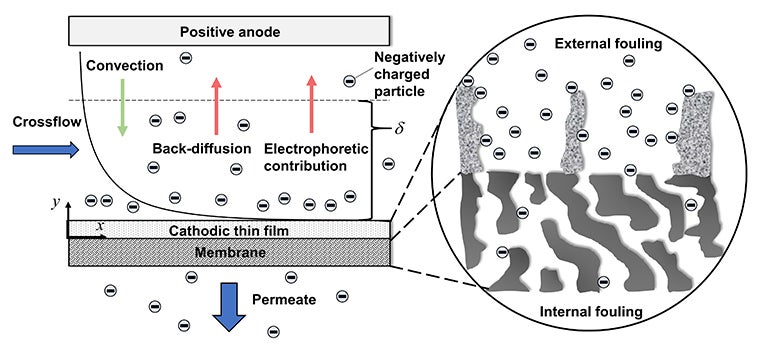Ultrafiltration with Carbon Nanotube Charged Membranes
Overview
Ultrafiltration (UF) remains an attractive approach for protein processing due to its robustness and scalability. Membrane-based separation processes, however, have intrinsic limitations including permeate flux and yield decline during operation. Through our collaboration with Prof. David Jassby, Associate Professor in the Department of Civil and Environmental Engineering at UCLA, we are investigating improvements in protein filtration and separation using electrically conductive poly(vinyl alcohol) and carboxylated multi-walled carbon nanotube (PVA-CNT) composite membranes.
In a process referred to as electroultrafiltration (EUF), application of large direct current (DC) fields across electrodes situated at opposite sides of the membrane during UF has been shown to effectively reduce membrane fouling rates and increase permeate flux during both cross-flow and dead-end filtration of wastewater. While EUF overcomes the membrane performance limitations associated with concentration polarization and fouling, the systems employing the technique suffer from high inefficiencies due to the placement of the electrodes. Prof. Jassby developed a composite membrane composed of an electrically conducting PVA-CNT layer, which acts as a cathode, above a polysulfone (PS) UF membrane and demonstrated improved inhibition of organic fouling during EUF of wastewater with an applied DC current field using the PVA-CNT membranes compared to the standard PS membranes.
Our research extends the use of PVA-CNT membranes for electroultrafiltration of single and binary protein solutions of alpha-lactalbumin and hen egg-white lysozyme. Compared to uncoated PS membranes, the PVA-CNT membranes have been shown to provide temporary enhancement in protein sieving during EUF of single protein solutions of both negatively and positively charged species.
Related Publications
Yeung R, Zhu X, Gee T, Gheen B, Jassby D, Rodgers VGJ (2020) Single and binary protein electroultrafiltration using poly(vinyl-alcohol)-carbon nanotube (PVA-CNT) composite membranes. PLoS ONE 15(4): e0228973.
